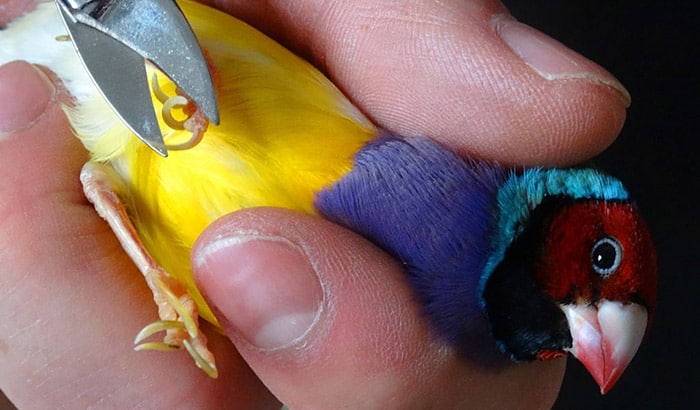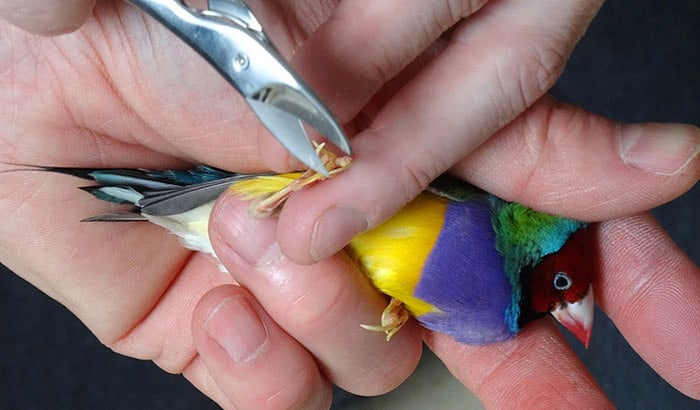Trimming a bird’s nail is also called “dremeling” or “nail clipping”. This process can be done by you at home. However, it requires the proper tools and knowledge to do this as safely as possible.
Birds can make it difficult for you when trimming their nails. They don’t like to stay still and might attempt to fly away as you work. But, birds’ nails should be trimmed regularly for their health!
This article will discuss how to trim birds’ nails without struggling to hold them in place or accidentally hurting them.
How to Trim Bird Nails by Yourself?
Step 1: Prepare Necessary Items.
You can trim your birds’ nails at home with a few simple tools.
- A good nail trimmer – There are many different trimmers available, so you should pick one that feels comfortable in your hand and is easy to use.
- A couple of clean towels – Make sure you take out some towels in a plain and pastel color and avoid colorful ones not to frighten your birds.
- Blood stopping powder and several cotton pieces
- A pair of gloves – Please wear protective gloves to prevent your hands from getting scratched in the process.
Step 2: Wrap your Bird in the Towel.
Gently and slowly make sure your bird gets used to the feeling of the towel. Let it touch the towel with its legs and complement them softly to encourage it.
Then, wrap the towel around its body, including its wings. If your bird is too stubborn and active, you might need to ask for help from a friend.
Step 3: Get your Birds used to having their Nails Trimmed.
If birds are afraid of trimming, they will struggle and injure themselves. You can get your pet used to this by doing small things at first, like touching or stroking its feet with the trimmer before actually using it for nail clipping.
Before you begin trimming, please take a good look at your bird’ nails so that you know what you’re dealing with when it comes time to clip them. Also, note whether any nails need more attention than others.
Step 4: Trimm the Nails.
Next, position the bird so its head is facing downwards and its wings are away from its body. This position will make it easier to see and access the nails.
If your bird is resistant to having its nails trimmed, try placing a small number of treats near its feet to distract it.
Carefully clip each nail, taking care not to cut too deep. If you are unsure how much to trim, it is better to trim less than more. You can always go back and trim more if needed.
Trimming both front and back claws should be relatively even if done correctly, but pay extra special attention.
Once you have trimmed all of the nails, recheck them for any rough edges or bleeding. If necessary, use a nail file to smooth them out.
Also, remember that birds might not be pleased about having their nails done at first but keep trying until they get used to it because this will help make it easier on them in the future.
Note: Remember that birds need time to adjust when their routine changes, so are patient with them, especially if they are resistant at first – it may take a few before they get used to having their nails trimmed!
Frequently Asked Questions
How often Should you Trim your Bird’s Nails?
Overgrown nails can cause problems, especially when it comes to birds being flighted, where their wings will be hindered if they have long claws that are not kept under control.
Therefore, trim your birds’ nails regularly every two weeks or as often as you think they need. Also, check their nails after trimming again before releasing them back out with other birds to prevent issues from happening due to an accident during the clipping process.
Why is Trimming Nails Important?
When birds are in the wild, it’s their job to fly from one place to another. This means that they spend a lot of time using their nails for climbing and gripping branches. They don’t usually have problems snagging or breaking nails during this activity because birds use them every day!
However, when birds live in cages, these activities aren’t something they get to do regularly- if at all. This can lead to overgrown bird nails, which put your pet at risk for injuries while playing and exercising.
In addition, long nails tend to snag on carpets – not only potentially damaging your floors but also causing tears in feathers and emotional stress for the bird!
All birds have nails on their feet, but some birds are more prone to overgrown nails than others. Cockatiels and parrotlets are two birds that often need their nails trimmed. Meanwhile, finches and other small birds tend not to require nail trimming as much because they don’t land from high spaces in the same way larger birds do!
Conclusion
It is important to trim your bird’s nails every week or two. Great care from bird owners will help prevent the claws from getting too long and causing a variety of issues in your home, such as scratching furniture, ripping up carpets, and even hurting others.
If you have any doubts about how to properly trim your pet’s nails, please leave a comment. We will try to respond as soon as possible.


